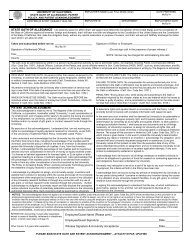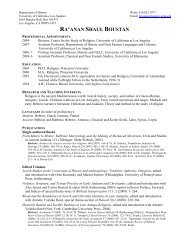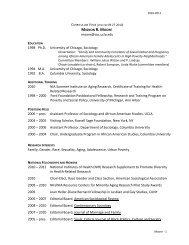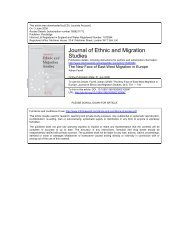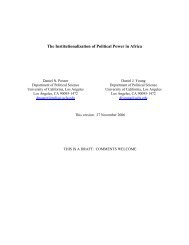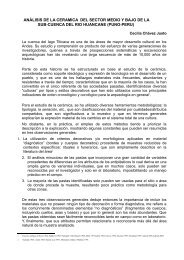The Long-Term Effects of Africa's Slave Trades - Social Sciences ...
The Long-Term Effects of Africa's Slave Trades - Social Sciences ...
The Long-Term Effects of Africa's Slave Trades - Social Sciences ...
Create successful ePaper yourself
Turn your PDF publications into a flip-book with our unique Google optimized e-Paper software.
Table 8: Testing potential channels <strong>of</strong> causality.<br />
Without colonizer fixed effects With colonizer fixed effects<br />
OLS IV OLS IV<br />
coef s.e. coef s.e. coef s.e. coef s.e.<br />
Dependent variable<br />
Pre-colonial state dev. −.026 ∗∗ (.013) −.069 ∗∗∗ (.025) −.026 ∗ (.015) −.064 ∗∗ (.025)<br />
Rule <strong>of</strong> law −.073 ∗∗∗ (.020) −.118 ∗∗∗ (.039) −.078 ∗∗∗ (.018) −.095 ∗∗∗ (.032)<br />
Ethnic fractionalization .040 ∗∗∗ (.009) .065 ∗∗∗ (.018) .041 ∗∗∗ (.010) .066 ∗∗∗ (.019)<br />
Cultural diversity .029 ∗∗∗ (.007) .050 ∗∗∗ (.014) .031 ∗∗∗ (.008) .051 ∗∗∗ (.014)<br />
ln per capita GDP in 1950 −.026 (.020) −.058 (.038) −.030 (.021) −.062 (.037)<br />
Notes: <strong>The</strong> coefficients and standard errors reported are for ln(exports/area). In the IV regressions,<br />
the instruments are the four distances to the markets <strong>of</strong> demand in each <strong>of</strong> the four slave trades.<br />
<strong>The</strong> colonizer fixed effects are indicator variables for the identity <strong>of</strong> the colonizer at the time <strong>of</strong><br />
independence. Coefficients are reported with standard errors in brackets.<br />
∗∗∗ , ∗∗ , and ∗ indicate<br />
significance at the 1, 5, and 10 percent levels.<br />
effects <strong>of</strong> the slave trades may be through state development, domestic institutions,<br />
or ethnic fractionalization, which is an important determinant <strong>of</strong><br />
domestic policies such as the provision <strong>of</strong> public goods. In 1950, nearly all<br />
countries were still under colonial rule, and therefore a country’s domestic<br />
institutions and policies were externally imposed. 26 If the slave trades affect<br />
income through the development <strong>of</strong> domestic institutions and policies, then<br />
we would expect the relationship between the slave trades and income to be<br />
much weaker, or even non-existent, when a country’s institutions and policies<br />
are determined externally by a colonial power. <strong>The</strong> weak relationship<br />
between slave exports and 1950 income is consistent with this. 27<br />
7 Robustness and Sensitivity Analysis<br />
<strong>The</strong> first set <strong>of</strong> tests that I perform check the robustness <strong>of</strong> my results to<br />
the construction <strong>of</strong> the slave export data. As I noted in Section 3, the data<br />
used to construct the slave export estimates for the Saharan, Indian Ocean<br />
26 In 1950 only four African countries were independent. Ethiopia had never been colonized,<br />
while Liberia, South Africa, and Egypt had gained independence.<br />
27 An alternative way <strong>of</strong> expressing this is that income in 1950 may not be a good<br />
indicator <strong>of</strong> a country’s economic development at that time. High income may simply<br />
reflect high levels <strong>of</strong> extraction by the colonizer rather than a good economic environment.<br />
37




